Virage Sauté Pédale
Historically there has been a lot of “skiing with consequence” going on in Europe and America. Many of its roots can be traced to Chamonix, France. This is the hub for modern alpinism, with a large concentration of snow and ice climbs waiting to be skied.Things began with the first generation of skieurs de impossible like Sylvain Saudan, with his first descent of the Spencer Couloir on the Aiguille du Blatier in 1967. At an average angle of 51°, it was one of the first notable alpine ice climbs to be skied. It became apparent to Saudan that the traditional parallel jump turn was too taxing to sustain at high altitudes and also too vulnerable, gaining far too much momentum on such steep terrain. New techniques needed to be developed for the super steep. Saudan made the “windshield wiper” turn famous. We couldn’t quite figure out the concept until one rainy day at the Geneva airport when we realized that the windshield wipers of French cars are not synchronized the way they are in America. Then the relation to Saudan’s unique and possibly inimitable pattern of ski movements became clear. However those were the days before the pedal hop.
As ski evolution continued in the western Alps, the question was: how far could it go? Could the biggest of the snow/ice couloirs and faces be skied? Up until then, they were considered huge prizes just to be climbed by alpinists, let alone descended by ski.
The next generation was led predominantly by Patrick Vallençant and Anselme Baud, ski buddies from Chamonix. They teamed up and designed projects which they sometimes skied together, sometimes alone. The mid-70s brought excellent snow conditions which they could monitor day by day to pick the perfect one. Among their projects of grande course ski descents were such notable routes as the Whymper Couloir and Couturier Couloir on the Aiguille Verte, the north face of Aiguille Blanche de Peutérey and the Peutérey Ridge from the summit of Mont Blanc.
Patrick Vallencant demonstrates the Pedal Hop Turn
As their routes increased in length and commitment, Vallençant and Baud developed an even more advanced technique. Their descents became so demanding both from a physical and technical standpoint that they were forced to find the most effective maneuver, one that was energy-efficient and generated the least momentum. Their high altitude descents exceeded 55°, sometimes tipping the 60° mark. Some were up to 4,000 feet in length. Their maneuver has been called virage sauté-pédale, or the pedal-hop turn.
In the late 80s, Anselme came to the Sierra Nevada to look at current trends in telemark skiing. Together we skied peaks and couloirs of the high Sierra. We were fortunate to experience firsthand his presentation of this turn. He showed us a number of details that definitely refined our variation of this important maneuver. We have found the pedal hop to be equally valuable for telemark or alpine touring equipment.
By technical skiing standards, the pedal hop is not a complicated turn. It’s a relatively simple movement pattern that maintains an anatomically advantageous stance. It works best on firm or medium-soft snow where a solid platform can be established. The turn can be accomplished in its full form, from stop-to-stop, or variations of it can be incorporated in continuous turn-to-turn skiing within an individual’s comfort zone.Work first on the first half of the pedal hop in a static position until you can synchronize the movements without thinking about them. As you commit to the turn, think about the landing. That’s the key. Maintain a centered, balanced stance until you are stable again.
This amazing turn is almost laughably simple. The trick is a good cross-over movement. The concept is to move one’s mass in the direction of the turn, maintaining a body position that remains perpendicular to the slope.
The pedal hop can be a remarkable addition to your bag of tricks. Valuable parts of it can be incorporated into your everyday skiing. The need for good cross-over, early weight transfer, and independent leg action are all valuable.
Practice the pedal hop and understand it, and you’ll continue to build your repertoire and enhance your experience of the mountains.
- Start from a standstill position. A steeper slope is actually better than a lower-angled one. You can initiate the turn with a single or double pole plant. Let’s start with a double for increased stability. Set your uphill pole ahead of your uphill boot, downhill pole behind your downhill boot, close to your ski. Make sure your shoulders and torso face downhill.
- With all your weight on your downhill ski, lift your uphill ski. Then set it down and make an active weight transfer onto it, extending your uphill leg, just enough that you unweight your downhill ski. Practice just this movement a number of times with your poles remaining planted until it becomes well synchronized.
- As you transfer your weight to your uphill ski, make a diverging movement with your unweighted downhill ski. You do this by opening your hips into the fall line and steering with your lower leg. Drop the tip of your ski into the plane of the slope, momentarily crossing the tail over your uphill ski. Practice these movements in this static position until they are all well synchronized.
- Now you are ready to commit to the turn. As you are making the movements, cross your center of gravity over your skis downslope. Commit yourself by leaning out and downhill. As you feel yourself crossing the point of no return, press off your uphill ski.
- . . . and quickly bring it around. When you re-engage that ski as your new downhill ski . . .
- . . . concentrate on landing on it alone dead center. As you land, do whatever it takes to stay centered over your downhill ski.
- As you complete the turn, allow your uphill ski to drift up-slope to form a V. This position will let your hips accommodate the steepness of the slope and assure that your weight remains primarily on the downhill ski.
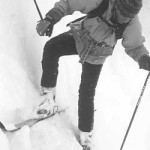
Ready to set the weight on the uphill ski, while retracting the downhill and pitching forward into the next virage saute-pedale.
Editor’s note: The beauty of this turn is how you can initiate from a dead stop on deadly steep terrain with a minimum of energy. It requires absolute finesse, but with good technique it flows easily and quickly. Once you have momentum, the pedal-hop becomes dynamic, requiring only light hops of your downhill ski to transition around to your new downhill ski. Truly a joy to execute on 45°—50°.
This article first appeared in Couloir Magazine, Volume VI-3, February/March 1994 under the title “Virage Sauté Pédale- the Pedal Hop Turn” by Bela and Mimi Vadasz. Edited by Craig Dostie
© 1994

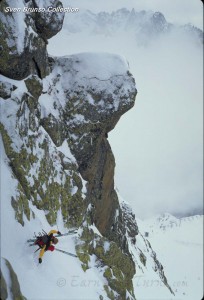
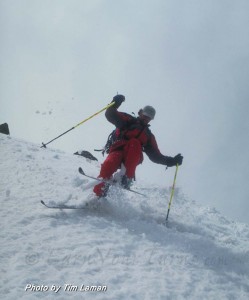
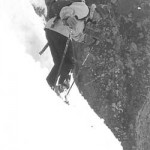
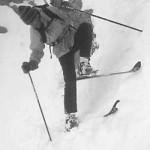
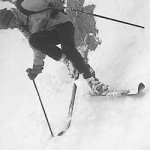
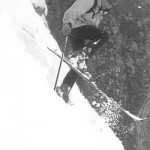
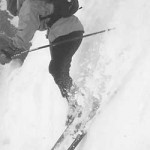
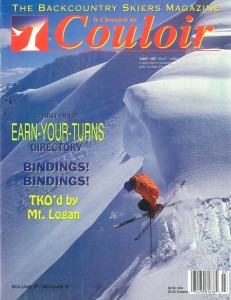
1 pings